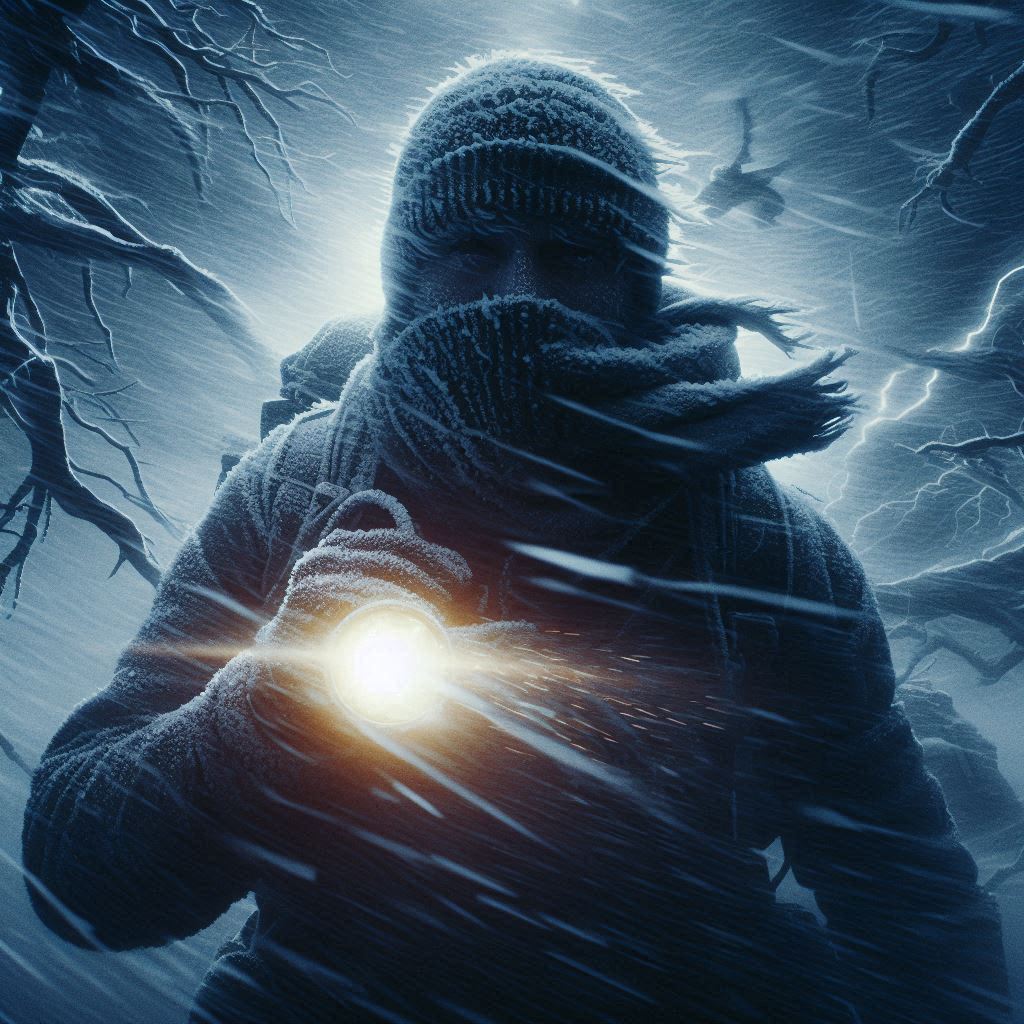[Opening Scene: A violent storm rages, wind howling, trees bending under the pressure, and a solitary figure fights to stay on their feet against the fury of the elements. The camera zooms in on their frost-covered face, illuminated by the flickering light of a headlamp.]

[Script Begins]
You’ve witnessed it before—a deluge of water engulfing entire neighborhoods, a wildfire surging through forests with the force of a thousand suns, or a bone-chilling blizzard transforming vibrant cities into deserted ghost towns overnight. But picture this: you’re alone. The air feels thick, electric. The ground beneath you shifts, subtly trembling. You know what’s coming. You’ve been warned. But nothing can truly prepare you for what lies ahead.
The sky darkens unnaturally fast. Your phone buzzes—weather alert. Tornado incoming. Fifteen minutes. That’s all you have. You glance around. Are you equipped? Or is survival down to luck?
This isn’t a story. Extreme weather isn’t a distant possibility anymore—it’s here. And your survival relies on one thing: preparation. Tonight, we’re diving into the ultimate guide for survival gear—not just a checklist, but a lifeline. Because when nature strikes, it doesn’t wait.
[Scene transition: The aftermath of a disaster—debris scattered, silent streets, a lone backpack amid the wreckage.]
The Reality of Extreme Weather
In the past decade, we’ve witnessed hurricanes tearing apart cities with winds strong enough to uproot ancient trees. Heatwaves have turned roads to molten tar, and floods have submerged towns, as if from a nightmare. The uncomfortable truth? We’re all vulnerable.
It’s not a matter of if extreme weather will hit—it’s when. And when it does, will you be ready?
It all begins with one essential item—the kind that could mean life or death. A waterproof map when your GPS fails. A hand-crank radio to stay informed when power lines collapse. A firestarter when the cold threatens to take over. Each piece of gear has its story—a story of survival.
[Montage of people using survival gear: a woman unfurling an emergency blanket in the snow, a family lighting a stove during a blackout, a lone hiker tuning a hand-crank radio in the wilderness.]
The Weight of Preparedness
Close your eyes and imagine this: You’re stranded. The storm of the century has isolated you—no power, no water, no way to call for help. What’s in your bag? What’s in your home? Do you know where to begin?
Your first line of defense is your bug-out bag—a compact survival kit meant to sustain you for 72 hours. But here’s the catch: it’s not just about having one. It’s about having the right one.
What Makes the Cut
[Scene shifts to a dimly lit table laid out with survival gear. A gloved hand picks up each item, inspecting it carefully.]
Start with the basics: water, food, and shelter. But don’t underestimate the details. A simple LifeStraw could save you when every water source is contaminated. And those energy bars? Not enough. What you need are long-lasting rations, packed with enough calories to keep you going when exhaustion sets in.
Shelter is next. A lightweight tarp or bivvy sack may seem basic, but in a downpour, it becomes your lifeline. Add a reflective emergency blanket—not only does it trap heat, but it signals rescuers when you’re out of options.
And for light? Forget typical flashlights. Think headlamps with long battery life and waterproof casings, or better yet, solar-powered lanterns that recharge during the day so you’re never left in the dark.
The Unseen Threats
Surviving isn’t just about staying warm and hydrated. It’s about keeping yourself safe in ways you may never have considered.
Air quality can quickly degrade during wildfires or chemical spills. That’s where an N95 mask or portable air purifier comes into play. And don’t forget a compact first aid kit—a minor injury in the wilderness can quickly become life-threatening.
[Quick flashbacks: a man wrapping a wound with gauze, a child putting on a mask as ash falls around her, a woman starting a fire in the rain.]
When Seconds Count
Survival isn’t just physical; it’s mental. Panic is the enemy. Training is your ally. Can you light a fire in the rain? Signal for help when no one is nearby? Navigate without GPS? These aren’t just skills—they’re life-saving essentials. And they begin with the gear you carry.
A whistle: three sharp blasts, universally understood as a distress signal.
A multi-tool: your Swiss Army knife on steroids, capable of cutting, screwing, and sawing your way out of danger.
A personal locator beacon: your final lifeline when you’re stranded miles from civilization.
Real Stories of Survival
[Scene transitions to survivors sharing their stories. A man describes being trapped in his car during a blizzard. A woman recounts evacuating just before a wildfire consumed her home. Each story is raw, emotional, and underscored by the gear that saved their lives.]
The Ultimate Test
The real test of your survival kit? When everything goes wrong. And it will. Batteries fail. Phones die. Roads vanish. Your gear must withstand every challenge.
Do you have a backup plan? A backup for your backup? Your gear must be durable, adaptable, and fail-proof. It has to survive both the desert’s heat and the tundra’s cold. And it must evolve with you.
[Scenes of extreme environments: a desert, a frozen tundra, a dense jungle. Gear in action, blending seamlessly with the terrain.]
A Call to Action
As the storm rages in your mind, ask yourself: What’s holding you back from being prepared? Complacency? Overconfidence? The belief that “it won’t happen to you”?
Survival isn’t about fear—it’s about respect. Respect for nature’s power. Respect for life’s unpredictability. And respect for yourself and your loved ones.
Because at the end of the day, survival isn’t just about the gear—it’s about the mindset. And that mindset starts here. Now.
[The screen fades to black, leaving only the sound of the storm. A single line appears: “Will you be ready?”]
[Scene Notes for Visual Direction]
